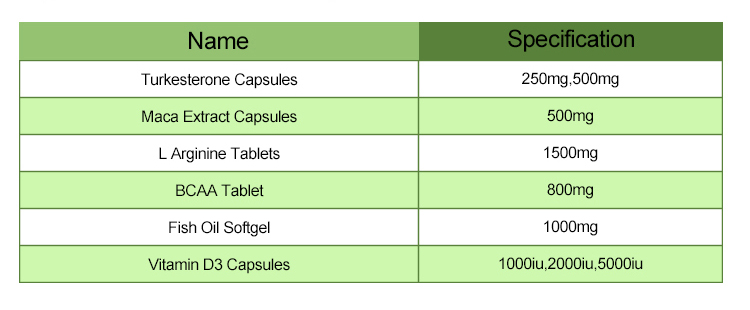Turkesterone capsules typically contain turkesterone as the main active ingredient. Turkesterone is a compound often marketed as a natural anabolic agent, purported to have muscle-building and performance-enhancing effects. While I can provide a general outline of how such capsules might be formulated, it’s important to note that the specific formulation can vary based on the manufacturer and their proprietary blend. Here’s a typical outline of the materials and methods used in producing Turkesterone capsules:
Materials of Turkesterone Capsules:
1.Turkesterone Extract: The primary active ingredient, usually extracted from plants like Ajuga turkestanica or Rhaponticum carthamoides. This extract contains the bioactive compounds responsible for the purported benefits.

2.Excipients: These are inactive ingredients added to the formulation to aid in the manufacturing process, improve stability, and enhance absorption. Common excipients include:
Fillers: Such as microcrystalline cellulose, dicalcium phosphate, or maltodextrin, used to bulk up the capsule content.
Binders: Like cellulose derivatives or starches, used to hold the capsule ingredients together.
Disintegrants: Such as croscarmellose sodium or crosslinked PVP, which help the capsule dissolve in the digestive tract.
Flow agents: Such as magnesium stearate or silicon dioxide, used to improve manufacturing efficiency by preventing ingredients from sticking to machinery.
3.Capsule Shells: Usually made from gelatin or vegetarian alternatives like cellulose or pullulan, which contain and protect the powdered ingredients.
Methods of Turkesterone Capsules:
1.Extraction of Turkesterone: The active compounds are typically extracted from the plant source using methods such as solvent extraction, supercritical fluid extraction, or other proprietary techniques employed by manufacturers. This process concentrates the desired compounds while removing impurities.
2.Formulation Development: Based on the desired dosage and efficacy, the Turkesterone extract is blended with excipients to create a homogenous mixture that can be accurately dosed into capsules.
3.Capsule Filling: The formulated mixture is then filled into empty capsule shells using capsule-filling machines. The capsules are typically filled to a standardized weight or volume to ensure consistent dosing.

4.Quality Control: Throughout the manufacturing process, quality control measures are implemented to ensure the capsules meet safety, purity, and potency standards. This may involve testing raw materials, in-process samples, and finished products for identity, potency, microbial contamination, heavy metals, and other quality attributes.
5.Packaging and Labeling: Once the capsules pass quality control checks, they are packaged into bottles or blister packs and labeled with dosage instructions, ingredient lists, and other relevant information required by regulatory authorities.
It’s essential for consumers to be aware that the efficacy and safety of Turkesterone supplements can vary based on factors such as the quality of the raw materials, the manufacturing process, and individual differences in metabolism and health status. It’s advisable to consult with a healthcare professional before starting any new supplement regimen.
